Getting the Most Out of Your Video: Distribution Best Practices
You’ve wrapped a video project, the final file’s in your inbox, and it looks fantastic. But now what?
7 min read
![]() StoryTeller Team
:
November 19, 2021
StoryTeller Team
:
November 19, 2021
Editor's note: This post originally published in 2020 and was updated in September 2023.
Did you know that consumers are watching over 5 billion videos on YouTube every single day? That doesn't even include Facebook, LinkedIn, Instagram, Twitter, Vimeo and other videos hosted on native platforms. Consumers today have a voracious appetite for video content.
For some content marketers, there is a disconnect between how they view video personally and how they believe their organization should leverage this tactic for their marketing strategy. For example, when we watch an online video, we love the content and we do not like the ads, so we click "Skip Ad" as quickly as we can. Yet, when it comes to producing video content, most organizations can't keep themselves from making commercials instead of compelling content or emotionally resonating videos.
So, how do you know if you are stuck in old-school thinking when it comes to creating video content?
Video can be the cornerstone of your content marketing strategy as long as you understand that it's more than a brochure.
So if you are stuck in the past, how do you take your video production to the next level? Here are some video production best practices to help you get started.
It's not enough to "just create a video" in the 2020's. There are tons of companies, creators and thought leaders that are creating great content in just about every industry. That doesn't mean that you shouldn't be creating video content, it just means you have to start with a purpose to have success.
All of these are fantastic goals, but they all require different videos. So make sure you are starting with ground zero when it comes to creating a video.
Understanding your audience is a universal challenge that all marketers have to face. Really understanding your target audience is about more than the demographic makeup. It's about identifying what's going on in their mind's eye, and knowing what will motivate them to make a decision.
If you haven't spent time understanding the mindset and drivers of your target audience. Start there. We've got an easy template that walks you through the process of creating a target audience in a way that will help you speak to their core needs.
Not every prospective buyer is looking for the same thing. Just like when you go to the mall you'll notice some serious shoppers who are planning to spend, some window shoppers who are just looking for inspiration (or something to do), and of course, those who are there for some snacks.
In a way, this is how people use the internet to search for products and services. Some people will come to your website ready to sign the dotted line, but most are there to explore and see what you have to offer. Video can support this process, but it has to align with the "buyer intent" or what the buyer is looking to accomplish.
There are three main stages that buyers go through when researching and buying online:
Awareness Stage: The awareness stage is the most obvious place to leverage video. When people don’t know anything about your company or products, the power of the play button becomes the magnet that attracts them to check out your content. Still, it needs to be the right kind of video — short, with a specific point. Think about the samples at the grocery store — a small bite of pizza is less imposing than a full slice, so you’re more likely to actually try the small sample.
Decision Stage: Congratulations, your prospect is in the decision stage. They are aware of your business, you piqued their interest, and now they’re trying to decide if they trust your business. You’ve done a lot of work to get them to this point, but they still need to make the ultimate decision — to choose you over the competition. It’s a great place to be, but it’s also tricky. In fact, this is where it’s even more important to match the right video to the right person because their concerns are becoming more specific. When should you show them testimonials, case studies, or even send a personalized sales video? Every situation is different, but here are your building blocks.
If you aren't sure what these types of videos look like, check out this page with examples of different videos for every stage in the buyer's journey.
It's not enough to just publish any video. Take the time to plan and create a video that is high-quality. It's okay if there are other great examples of the same type of video out on the internet, but the important thing is that you can't just create a B-grade version of the same videos that are already available.
A video is not a smarmy sales pitch, or content that adds no value to the viewers. If your video is nothing more than a commercial for you to pitch your product, you'll lose your viewer. Remember, they want to learn something or understand what's in it for them. Produce a helpful video and you'll create a relationship with your prospects and viewers.
What do you want viewers to do when they reach the end of the video? Don't leave them hanging! Suggest the next step with a call-to-action so they can:
For every piece of content you create, there should always be another place you can direct your viewers when they are done watching your video.
This is not the wild west of the internet anymore, you have the ability to test and measure EVERYTHING. Use a video player that has advanced analytics like Wistia, Vidyard HubSpot Video, or BrightCove. These platforms will give you insights into viewer behavior, like how much of your video was watched, which specific contacts watched your videos, and who clicked on your CTAs.
Analyze this information and you can start to understand what videos work well with your audience and when they start to tune out.
With the right optimization and tagging, your videos can be found online for people who are already looking for your products and services. Here are a few tips to consider:
These best practices are important for making sure that you are getting the most out of your videos. Skip any of these steps and your chances of creating a successful, useful, and interesting video will go down drastically.
Online viewing habits and preferences are constantly changing and there are techniques you can use in production to make your video feel relevant and new. Here are a few trends you can't ignore.
In 2018, Buffer conducted an in-depth study to uncover which of these video rations would reign supreme. And the clear winner was square video. A mere two years later in 2020, they've updated their study and found that vertical outperforms square. Not only did this continue in 2021, it also reminds us two things:
Why are vertical videos (aka "Portrait videos") very popular today? Simply put: Social Media and the shape of our phones. The rise of Instagram Stories, a feature borrowed from game-changing social media platform Snapchat, has become one of the most popular ways for individuals and businesses to express themselves. Why? Because it's extremely easy to film with a cell phone and it fits the full screen of your phone seamlessly. Instagram Stories, Snapchat, and even YouTube have jumped on the vertical video bandwagon. And unless the shape of our phones change in the next few years, this social media trend doesn't look like it'll disappear anytime soon.
2. Drone Video
While drones have been out on the market for a long time now, they are becoming more and more affordable with lots of great features and that makes them a premier choice for video production companies. If you are doing a company overview piece or have a visually appealing outdoor space (think golf courses) there's nothing that captures exteriors like drone video.
Creating a video for social media has a whole different set of considerations that you might want to keep in mind before you publish your video online.
There are so many different things that you need to take into consideration when it comes to video. By following these video production best practices, you can create a piece that will serve your needs well in the short and long term.

You’ve wrapped a video project, the final file’s in your inbox, and it looks fantastic. But now what?

You don't need a Hollywood production to get attention online. In fact, you don't even need a fancy camera. You just need a good idea — and a good...

Editor's Note: This blog was updated for accuracy and relevance on August 27, 2024. Here's a multiple-choice question for you. When a movie ends, and...